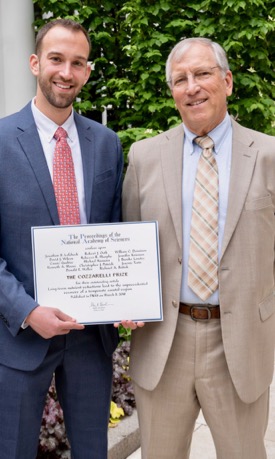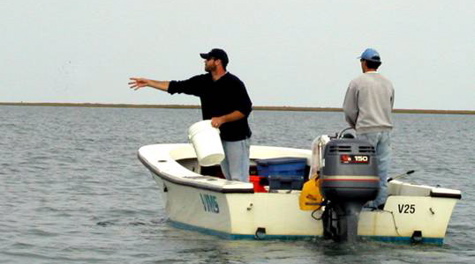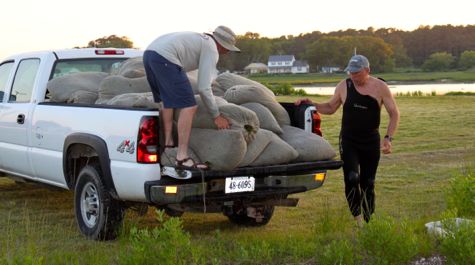CERF honors Orth with Lifetime Achievement Award
VIMS emeritus professor recognized as leader in seagrass science, restoration
The Coastal and Estuarine Research Federation has chosen emeritus professor Dr. Robert “JJ” Orth of William & Mary’s Virginia Institute of Marine Science as a joint recipient of its 2021 Odum Award for Lifetime Achievement, along with Dr. Ken Heck of the University of South Alabama and the Dauphin Island Sea Lab.
The award committee says the selection honors Orth and Heck’s individual and joint achievements, as well as “sustained accomplishments throughout their long and distinguished careers, contribution of seminal papers that have shaped estuarine-coastal science, and sustained engagement with and contributions to CERF.”

The pair’s nomination letter notes that “both candidates have shaped our understanding of seagrasses and marine ecology—through a series of foundational papers, edited volumes, and synthetic reviews. Moreover, their science has had a lasting societal impact through their long and successful track record of integration with management and policy.” The letter also praises the pair for “their strong records of mentoring students and postdocs.”
Orth’s most noticeable success in seagrass restoration now graces the seaside bays of Virginia’s Eastern Shore. His team first began sowing the bays' shallow waters with eelgrass seeds in 1999. Barren at the time, they are today home to nearly 10,000 acres of lush eelgrass meadow, making them the largest example of seagrass restoration in the world. In fact, they now hold 75% of the world’s restored seagrass acreage.
Orth’s success in Virginia helped sow a global effort to restore and maintain seagrasses as key components of coastal marine ecosystems. These submerged flowering plants—in trouble worldwide due to nutrient pollution and other factors—provide habitat and nursery grounds for fish and crabs, serve as food for waterfowl and other animals, clear the water by reducing wave action, absorb excess nutrients, and reduce shoreline erosion.
 Seagrasses are also an excellent measure of the condition of Chesapeake Bay and other coastal waters because their health is closely linked to water quality. Annual values of seagrass acreage in the Bay come from VIMS’ Submerged Aquatic Vegetation Monitoring and Restoration Program, now under the leadership of Dr. Chris Patrick. Created by Orth in 1978, the “SAV Program” is now the de facto yardstick for measuring and sustaining progress toward the Chesapeake Bay Program’s restoration goals, and serves as a model for the development of similar programs around the world. Indeed, Orth has been called the “Johnny Appleseed” of global seagrass restoration efforts, sharing lessons learned in Virginia with colleagues and governments in Scandinavia, and together with Heck, in Australia.
Seagrasses are also an excellent measure of the condition of Chesapeake Bay and other coastal waters because their health is closely linked to water quality. Annual values of seagrass acreage in the Bay come from VIMS’ Submerged Aquatic Vegetation Monitoring and Restoration Program, now under the leadership of Dr. Chris Patrick. Created by Orth in 1978, the “SAV Program” is now the de facto yardstick for measuring and sustaining progress toward the Chesapeake Bay Program’s restoration goals, and serves as a model for the development of similar programs around the world. Indeed, Orth has been called the “Johnny Appleseed” of global seagrass restoration efforts, sharing lessons learned in Virginia with colleagues and governments in Scandinavia, and together with Heck, in Australia.
A lifetime of great friendship and research
Orth says the award is “a real honor given how many people get nominated,” and adds that his partnership with Heck “has been a lifetime of great friendship and great research, both as a team and individually.”
“Ken and I began working together in the lower Bay in 1976 and published several papers from the early work,” says Orth. “Since then, we’ve worked in the Chesapeake Bay and Australia, co-chaired many seagrass sessions at CERF, and were involved in two NCEAS workshops, whose summary papers each now have more than 2,000 citations.” This metric, a count of how many times a particular paper is cited in other publications, is a common means by which researchers judge scientific impact.
All told, Orth and Heck have authored nearly 500 publications, including 56 as co-authors, with many appearing in high-impact journals such as Science, Proceedings of the National Academy of Sciences, BioScience, and Global Change Biology. They have each edited two books, numerous special issues, and contributed scores of conference proceedings and technical reports. Their work has been widely cited and is held in high regard in the academic community, particularly in the areas of marine science, ecology, and seagrass biology. Together, they have over 52,000 citations on Google Scholar, indicating lasting and sustained contributions over the years.
Orth and Heck have also each established independent lines of research that have benefited management, conservation, and other applications. Their reviews and synthesis work have brought attention to global declines in seagrass, revealed its vulnerability to human stressors and climate change, and raised awareness of the need for seagrass restoration efforts in the conservation world.
The Odum Award also honors Orth and Heck for their many contributions to CERF as long-standing, highly engaged members. Both have served CERF in numerous leadership positions including President and Past President; Heck also served as Associate Editor for Estuaries and Reviews Editor for Estuaries and Coasts.
Orth, who retired in 2021, began his career at VIMS in 1969 when he enrolled as a graduate student to study the myriad animals that burrow beneath seagrass beds. After earning his master’s at VIMS and his Ph.D. from the University of Maryland, he returned to VIMS as a faculty member in 1974.
 The Odum Award adds to a long list of honors earned by Orth during his illustrious career. Previous awards include an Outstanding Scientist Award from the Commonwealth of Virginia in 2018; the Cozzarelli Prize from the Editorial Board of the Proceedings of the National Academy of Sciences, also in 2018; a Plumeri Award for Faculty Excellence from W&M in 2013; and the Outstanding Faculty Researcher Award from VIMS in 2011.
The Odum Award adds to a long list of honors earned by Orth during his illustrious career. Previous awards include an Outstanding Scientist Award from the Commonwealth of Virginia in 2018; the Cozzarelli Prize from the Editorial Board of the Proceedings of the National Academy of Sciences, also in 2018; a Plumeri Award for Faculty Excellence from W&M in 2013; and the Outstanding Faculty Researcher Award from VIMS in 2011.
Orth also chaired VIMS’ Department of Biological Sciences for more than 10 years. Dr. Linda Schaffner, VIMS’ Associate Dean of Academic Studies, notes that Orth’s research and advisory activities benefited several generations of VIMS graduate students. “By involving his many students in the hands-on worlds of science and policy,” she says, “he exemplifies all that we strive to achieve in our School of Marine Science.”
VIMS Dean & Director John Wells adds, “JJ is an internationally recognized leader in seagrass ecology who used cutting-edge research to solve real-world problems. Recent successes in restoring seagrass Virginia’s Eastern Shore depend to a large part on his tireless efforts over the past 40 years. He is highly deserving of this honor.”




